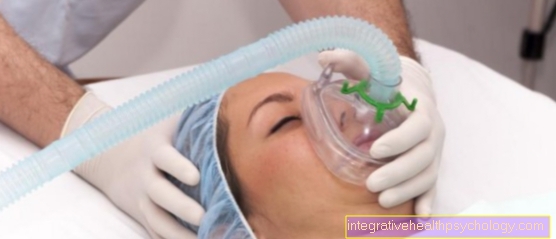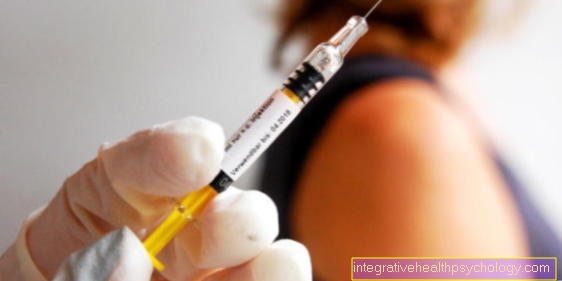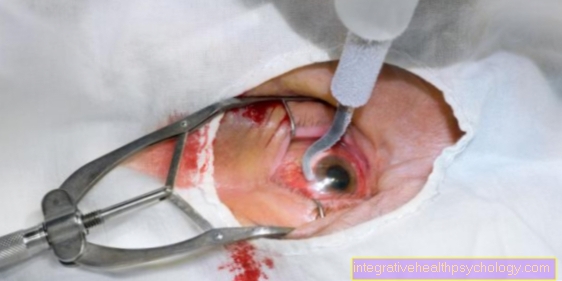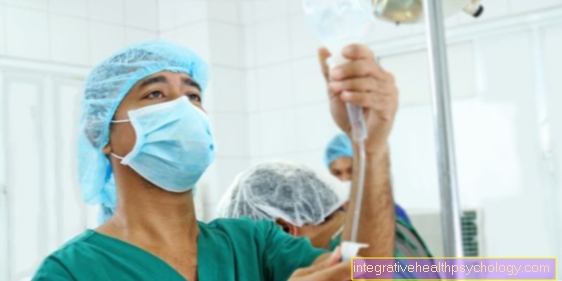What is a short anesthetic?
Short anesthesia is a form of general anesthesia.
It differs from regular general anesthesia only in its shorter duration and the lower dose of anesthetic.
Nevertheless, you sleep like with general anesthesia and do not notice the operation or the procedure.
Even with short anesthesia, the airway must be secured with mask ventilation, a larynx mask or a ventilation tube.
A short anesthetic is used, for example, during a gastroscopy or other invasive examinations that have a time frame of around 15 minutes.

Reasons for a short anesthetic
The short anesthesia is used particularly in invasive diagnostics.
Invasive diagnostics means that you have to choose procedures that are uncomfortable and painful, such as a gastroscopy or colonoscopy.
Such interventions can of course also be carried out without a short anesthetic.
In very anxious patients or difficult conditions, it can sometimes be beneficial to induce a short anesthetic. Even very short surgical interventions can be performed under short anesthesia.
Gastroscopy
For a gastroscopy, a small tube is inserted over the mouth and through the esophagus into the stomach and duodenum.
With the help of the camera, which is located at the front end of the tube, you can assess the mucous membrane of the gastric tract and detect any abnormalities, such as an inflammation or an ulcer.
The gastroscopy does not always have to be performed under a short anesthetic.
Some patients only want a sedative tablet and local anesthesia of the throat area.
Short anesthesia can only be chosen as the anesthetic method if the patient is very afraid of the examination or if the conditions are difficult.
However, this again harbors other risks, so that the benefit against the risks must be assessed beforehand.
Read more about this under: gastroscopy
Colonoscopy
During a colonoscopy, a tube is inserted through the anus into the large intestine.
The examiner can use a camera to look at the mucous membrane of the entire large intestine and, if necessary, act therapeutically.
Short anesthesia is rarely performed during colonoscopy.
The examination is uncomfortable, but not so invasive that an anesthetic is necessary.
Before the examination, patients can be given a sedative through the vein, which also reduces the pain.
Read more about the topic under: Colonoscopy
At the dentist
Short anesthesia for dental procedures is more the exception than the rule.
In order to be able to perform a short anesthesia, the dental practice must have a special operating area and work with an anesthetist who monitors the circulatory functions during the anesthesia.
In addition, short anesthesia is only useful for treatments lasting up to around 15 minutes.
Dental treatment that requires such anesthesia usually takes longer.
Therefore, sedatives are more likely to be used at the dentist, or a proper general anesthetic is carried out.
Learn more at: Anesthesia at the dentist
Advantage of short anesthesia
The advantage of short anesthesia is that during short interventions, consciousness and pain perception can be switched off very effectively for a short time. At the same time, short anesthesia is not as stressful as general anesthesia.
This is also due to the fact that, due to the short duration of the anesthesia, not so many anesthetics have to be given.
The airway must be secured during anesthesia, but ventilation through a mask is usually sufficient.
This has the advantage that you do not have to take the risks of ventilation with a breathing tube, such as damaging structures in the windpipe or the vocal cords.
Disadvantages, risks and side effects of short anesthesia
A general anesthetic is associated with significantly lower risks than general anesthesia.
Nevertheless, it is an intervention that should not be underestimated.
There may be bleeding at the skin site of the venous access or the veins may be irritated by the anesthetic.
This means that pain at this point can still occur a few days after the short anesthesia.
A mask is usually used for short-term anesthesia. If, however, ventilation with the mask is not sufficient, the anesthetist places a so-called larynx mask in the throat.
This mask encloses the area above the larynx with a soft cushion.
It is nowhere near as invasive as a breathing tube. Nevertheless, pain in the neck area can still occur a few days after the short anesthesia, which is triggered by the irritated mucous membrane.
You might also be interested in this topic: General anesthesia for a cold
With short anesthesia, it is very important that the patient is completely sober.
During the procedure, gastric juice can rise and flow through the windpipe into the lungs.
If it is just gastric juice, this is not quite as dangerous as if food particles also get into the lungs.
This can lead to pneumonia. After the general anesthesia, the patient should be supervised by a second person for 24 hours.
In addition, no machines may be operated and no participation in road traffic.
Read more on the topic:
- Aftermath of anesthesia
Which drugs and which means are used?
In short anesthesia, an anesthetic (hypnotics) and pain reliever are usually given through the vein.
The drug propofol is often used for hypnotics.
It has little effect on the circulatory system and does not restrict breathing as much.
In addition, falling asleep and waking up with Propofol is perceived as very pleasant.
One side effect of propofol is that it can lower blood pressure. It is therefore important to check your blood pressure regularly during short anesthesia.
Since Propofol does not have an analgesic effect, a pain reliever is usually also given.
In patients with pre-existing cardiovascular disease, one would tend to give the drug etomidate to induce anesthesia.
The benefit of etomidate in these patients is that it has virtually no circulatory effects.
Like propofol, etomidate is not pain reliever.
Etomidate also causes pain when injected into the vein, which is why you should inject the pain reliever first before giving etomidate. The opioid remifentanyl can be used as a pain reliever for short anesthesia.
It has a good analgesic effect and a short duration of action, which is advantageous for the short duration of the anesthesia.
Short anesthesia sequence
A short-term anesthetic is carried out by an anesthetist.
Before the anesthesia, the patient must have been informed about the risks of the anesthesia and risk factors such as previous illnesses must be clarified.
A sedative medication can be given some time before the procedure. In order to administer the drugs for the short-term anesthesia, the doctor puts an access into the vein.
The anesthetic and pain reliever are then given over it.
After only a short time, the patient falls asleep. It is now important that the anesthetist ventilate the patient through a mask, as the anesthetic will reduce the breathing effort.
In addition, vital parameters such as blood pressure and pulse must be checked regularly.
Duration of short anesthesia
A short anesthetic usually lasts from a few minutes to a quarter of an hour.
If the procedure is extended unplanned, measures must be taken to maintain the anesthesia longer.
This includes the administration of other anesthetics and intubation with a larynx mask or a ventilation tube.
What are the possible after-effects of short anesthesia?
The narcotics can cause nausea with vomiting after the short anesthesia.
However, this can be treated well with medication and is therefore long-lasting.
Pain in the area of the venous access or during ventilation with a larynx mask in the throat can persist for a few days.
Sometimes the short anesthesia can lead to reduced performance for a few days.
What are the alternatives to short anesthesia?
For procedures such as gastroscopy or colonoscopy, a short anesthetic is often not necessary.
Alternatively, sedatives can be taken beforehand or sedation can be carried out.
The sedatives are given as tablets.
You will be fully conscious during the procedure, but the medication will help reduce anxiety.
In addition, local anesthetics can be used to numb the examination area so that no pain is felt.
Sedation is a short-acting sleep medication administered through the vein. The patient falls into a twilight sleep, which only lasts for a short time and so does not notice much of the examination.
The advantage is that no ventilation is required.
However, no car is allowed to be driven or machines are operated for the rest of the day. Another alternative to short anesthesia is general anesthesia.
Before performing general anesthesia, however, the benefits must be weighed against the risks.
General anesthesia is much more complex than short anesthesia and is associated with greater risks. In addition, with general anesthesia, the airway must usually be secured with a ventilation tube.





























